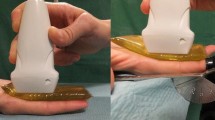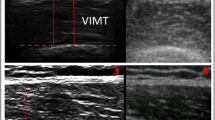Abstract
Purpose
This study sought to compare ultrasound-guided measurements of the abductor pollicis brevis (APB) using the water bath technique (WBT) and the direct contact method (DM) and investigate whether the DM can reproduce the measurements that would be obtained with a non-contact method, such as the WBT.
Methods
The APB muscles of 80 hands (40 healthy adults) were measured. The WBT was performed in a plastic container filled with water. The probe was placed adjacent to the skin surface without contact. In the DM, sonographic images were obtained with the probe and skin separated by sufficient transmission gel. The muscle thickness and cross-sectional area (CSA) were calculated with both methods. All subjects were examined three times by two examiners to estimate the inter- and intra-observer reliability. Bland–Altman analysis was performed to examine the agreement between the methods.
Results
No significant differences in the thickness or CSA of the APB were found. The interclass correlation coefficients for the WBT and DM showed almost perfect intra- and inter-observer reliability (range 0.87–0.94). There was no systematic bias between the techniques in the Bland–Altman analysis.
Conclusion
Similar to the WBT, the DM provides measurements of the APB thickness and CSA without causing morphometric changes.




Similar content being viewed by others
References
Phalen GS. The carpal-tunnel syndrome. J Bone Jt Surg Am. 1966;48:211–28.
Jan SVS, Rooze M. Anatomical variations of the intrinsic muscles of the thumb. Anat Rec. 1994;238:131–46.
Cooney WP, Linscheid RL, An KN. Opposition of the thumb: an anatomic and biomechanical study of tendon transfers. J Hand Surg Am. 1984;9:777–86.
Brown RA, Gelberman RH, Seiler JG, et al. Carpal tunnel release. A prospective, randomised assessment of open and endoscopic methods. J Bone Jt Surg Am. 1993;76:1265–75.
Nagaoka M, Nagao S, Matsuzaki H. Endoscopic release for carpal tunnel syndrome accompanied by thenar muscle atrophy. Arthroscopy. 2004;20:848–50.
Simon NG, Ralph JW, Lomen-Hoerth C, et al. Quantitative ultrasound of denervated hand muscles. Muscle Nerve. 2015;52:221–30.
Mohseny B, Nijhuis TH, Hundepool CA, et al. Ultrasonographic quantification of intrinsic hand muscle cross-sectional area; reliability and validity for predicting muscle strength. Arch Phys Med Rehabil. 2015;96:845–53.
Lee H, Jee S, Park SH, Ahn SC, et al. Quantitative muscle ultarasonography in carpal tunnel syndrome. Ann Rehabil Med. 2016;40:1048–56.
Javadzadeh HR, Davoudi A, Davoudi F, et al. Diagnostic value of "bedside ultrasonography" and the "water bath technique" in distal forearm, wrist, and hand bone fractures. Emerg Radiol. 2014;21:1–4.
Krishnamurthy R, Yoo JH, Thapa M, Callahan MJ. Water-bath method for sonographic evaluation of superficial structures of the extremities in children. Pediatr Radiol. 2013;43:S41–47.
Gupta S, Michelsen-Jost H. Anatomy and function of the thenar muscles. Hand Clin. 2012;28:1–7.
Kim JS, Seok HY, Kim BJ. The significance of muscle echo intensity on ultrasound for focal neuropathy: the median- to ulnar-innervated muscle echo intensity ratio in carpal tunnel syndrome. Clin Neurophysiol. 2016;127:880–5.
Zou KH, Tuncali K, Silverman SG. Correlation and simple lonear regression. Radiology. 2003;227:617–22.
Landis JR, Koch GG. The measurement of observer agreement for categorical data. Biometrics. 1977;33:159–74.
Doornberg J, Lindenhovius A, Kloen P, et al. Two and three-dimensional computed tomography for the classification and management of distal humeral fractures. Evaluation of reliability and diagnostic accuracy. J Bone Jt Surg Am. 2006;88:1795–801.
Bland JM, Altman DG. Statistical methods for assessing agreement between two methods of clinical measurement. Lancet. 1986;1:307–10.
Gruber L, Gruber H, Djurdjevic T, et al. Gender influence on clinical presentation and high-resolution ultrasound findings in primary carpal tunnel syndrome: do women only differ in incidence? J Med Ultrason. 2001;2016:413–20.
Arslan H, Yavuz A, İlgen F, et al. The efficiency of acoustic radiation force impulse (ARFI) elastography in the diagnosis and staging of carpal tunnel syndrome. J Med Ultrason. 2001;2018:453–9.
Ishida H, Watanabe S. Influence of inward pressure of the transducer on lateral abdominal muscle thickness during ultrasound imaging. J Orthop Sports Phys Ther. 2012;42:815–8.
Cartwright MS, Demar S, Griffin LP, et al. Validity and reliability of nerve and muscle ultrasound. Muscle Nerve. 2013;47:515–21.
König N, Cassel M, Intziegianni K, et al. Inter-rater reliability and measurement error of sonographic muscle architecture assessments. J Ultrasound Med. 2014;33:769–77.
Casarotto RA, Adamowski JC, Fallopa F, et al. Coupling agents in therapeutic ultrasound: acoustic and thermal behavior. Arch Phys Med Rehabil. 2004;85:162–5.
Balmaseda MT Jr, Fatehi MT, Koozekanani SH, et al. Ultrasound therapy: a comparative study of different coupling media. Arch Phys Med Rehabil. 1986;67:147.
Potter K, Reed CJ, Green DJ, Hankey GJ, et al. Ultrasound setting significantly alter arterial lumen and wall thickness measurement. Cardiovasc Ultrasound. 2008. https://doi.org/10.1186/1476-7120-6-6.
Acknowledgements
We thank Rebecca Jackson, PhD, from Edanz Group (www.edanzediting.com/ac) for editing a draft of this manuscript.
Author information
Authors and Affiliations
Corresponding author
Ethics declarations
Conflicts of interest
The authors have no conflicts of interest with regard to the presented research.
Ethical approval
All procedures followed were in accordance with the ethical standards of the responsible committee on human experimentation (institutional and national) and with the Helsinki Declaration of 1964 and later versions.
Additional information
Publisher's Note
Springer Nature remains neutral with regard to jurisdictional claims in published maps and institutional affiliations.
About this article
Cite this article
Fujino, K., Ohno, K., Fujiwara, K. et al. Sonographic morphometry of abductor pollicis brevis: can direct contact yield images comparable with those obtained by the water bath technique?. J Med Ultrasonics 46, 489–495 (2019). https://doi.org/10.1007/s10396-019-00945-3
Received:
Accepted:
Published:
Issue Date:
DOI: https://doi.org/10.1007/s10396-019-00945-3




